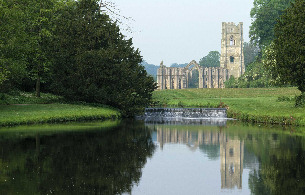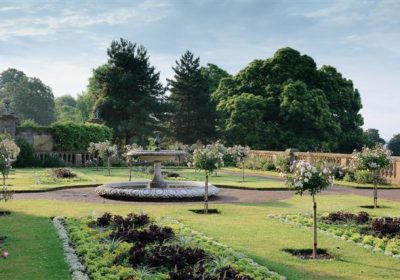Fountains Abbey and Studley Royal Water Garden
Description
Fountains Abbey & Studley Royal Water Garden, Ripon, nr Harrogate, HG4 3DY North Yorkshire
The National Trust
The National Trust
4 miles west of city of historic city of Ripon off B6265, 8 miles west of A1.
www.fountainsabbey.org.uk
Who created the garden?
John Aislabie was a socially and politically ambitious man, he inherited the Studley estate in 1693 and became the Tory Member of Parliament for Ripon in 1695. In 1718 his political career reached its pinnacle as he became Chancellor of the Exchequer.
In 1720 disaster struck. Aislabie was a principal sponsor of the South Sea Company scheme, the bill for which was promoted by him personally. After this vast financial operation collapsed (the South Sea Bubble), he was expelled from Parliament and disqualified for life from public office.
Aislabie returned to Yorkshire and devoted himself to the creation of the garden on his estate which he had begun in 1718. Once wild and wooded, he transformed the valley of the river Skell into one of England’s most spectacular Georgian water gardens. After his death in 1742, his son William extended his scheme by purchasing the remains of the neighbouring Cistercian Abbey. He also extended the landscaped area in the picturesque romantic style, contrasting with the formality of his father’s work. Between them, the two created what is arguably England’s most important 18th century Water Garden.
Style
The Water Garden, with its formal, geometric design and its extraordinary vistas, was inspired by the work of the great French landscape gardeners but is entirely individual in character. The only professional advice John Aislabie appears to have received was from the distinguished Palladian architect, Colen Campbell. His gardener William Fisher was an employee of the estate, and the garden works were carried out by local labour under the direction of local man John Simpson, who was succeeded in 1728 by the master mason Robert Doe from London.
The Garden today
A programme of restoration by the National Trust has restored the Water Garden to it’s former glory to be enjoyed by everyone. This is a place where you can truly relax and leave modern day stresses behind as you are transported to another era. The garden was the equivalent of today’s theme parks for Georgian pleasure seekers and attracted visits from nobility and the wealthy classes as well as some famous names; the poet Alexander Pope is known to have been a frequent visitor.
Take your time to stroll around this beautiful and romantic garden, let the cool secluded shady walks and grand green ampitheatres play with your senses. Let the artist’s eye guide across stepping stoned canals, elegant ponds and cascades, to the Georgian follies of the garden including rustic bridges, classical temples and statues and finally into the medieval ruins of the Abbey, providing an unforgettable experience which equally enthralls today’s visitor just as it did the Georgians.
The Temple of Piety, probably started in 1729-30 as a dedication to Hercules, is a perfect example of neo-Classicism and was later re-designed as a symbol of filial piety by William Aislabie soon after his father’s death in 1742. The Banqueting House, a deliberately rusticated building probably designed by Colen Campbell, was originally envisaged as an orangery, but later embellished and fitted out for the purposes its name suggests.
The High Ride on the east side of the valley commands magnificent views of the Water Garden. The Octagon Tower was first built in 1738 when the parapet, pinnacles and porch were added. Nearby are the reconstructed remains of Aislabie’s Kitchen, a romantic spot thought to be where food and drink was prepared for consumption by guests at the Octagon Tower.
Further along is the Temple of Fame, a rotunda built circa 1770, which captures another exquisite vista. At the end of the High Ride is Anne Boleyn’s Seat or "The Surprise View". Paintings show that here there was a statue of Henry VIII’s second queen, some say with her head under her arm and her back to the view of the abbey. The statue still exists, although not currently on display to the public, but what remains of the statue would suggest no such pose. But the name "Surprise View" is more apt – there is an astonishing view of the abbey ruins in the distance. The sight was designed to cause a sharp intake of breath, especially when the building’s sliding doors (no longer extant) were in place.
The Moon Pond, with its flanking crescent basins, provides the setting for three lead statues – Bacchus, Galen and Neptune. Other features of the garden include the Serpentine Tunnel, the Rustic Bridge, a Hermit’s Grotto – a popular feature in Georgian gardens, Half Moon Pond, Cascades, Formal Canal, Fishing Tabernacles, Drum Fall and the Seven Bridges Valley in the medieval Deer Park.
Open All Year: except 24/25 December, Fridays in Jan, Nov, Dec.
March – October 10am – 5pm
November – February 10am – 4pm
Last admission 1 hour before closing.
March – October 10am – 5pm
November – February 10am – 4pm
Last admission 1 hour before closing.
Adult £7.50 Child £4.00 Family £20.00
Name and credits for images of Fountains Abbey/Studley Royal
Reference: 109574
Description of image – Studley Royal Water Garden in autumn with Classical building,the Temple of Piety added by John Aislabie, a garden house with new stucco decoration by Giuseppe Cortese in the late 1740s.
Credit for photograph: Andrew Butler
Copyright: ©NTPL/Andrew Butler
For information on how to join the National Trust click http://





